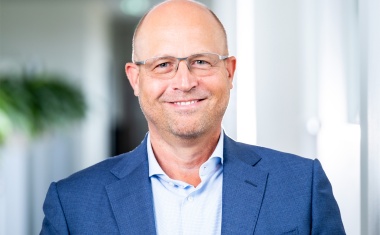AMS Osram and Fraunhofer IZM win Deutscher Zukunftspreis
“Digital light” LED technology brings intelligence and precision to the world of traffic lighting and enables novel, safety-related applications.
Last Wednesday, Germany’s President Frank-Walter Steinmeier honored the winners of the Deutscher Zukunftspreis 2024 at a formal ceremony in Berlin. The award was presented to a team of experts led by Dr Norwin von Malm and Stefan Grötsch from AMS Osram and Dr Hermann Oppermann from the Fraunhofer Institute for Reliability and Microintegration IZM for the technological implementation of their idea – an LED matrix that turns car headlights into projectors. The technology developed by the team opens up new possibilities for innovative designs thanks to its high-resolution light distribution and its energy efficiency.

As part of their Digital Light project, the researchers and their teams have completely rethought intelligent LED technology and established a basic technology that enables numerous new applications, even beyond car headlights. Norwin von Malm and Stefan Grötsch from AMS Osram and Hermann Oppermann from Fraunhofer IZM have developed a light source that is smaller, lighter, more efficient, more intelligent and more precise in its light output than conventional light sources. The new system will allow car headlights, for example, to illuminate the road ahead precisely and brightly without blinding or endangering oncoming traffic or pedestrians. A conventional low-beam/high-beam combination is not an option here because it must be possible to control the light’s spatial distribution and for the light itself to adapt to the respective situation. To achieve this, the new headlight does not use two light sources like conventional headlights. Instead, it relies on 25,600 LEDs in a matrix of 320 × 80 points, where each individual LED can be controlled with a digital signal. In combination with a special lens, this creates a headlight that works much like a video projector.
The new system requires minimal installation space and is highly efficient since only the LEDs that are actually required for the desired light distribution are switched on. Systems with passive light modulation, by contrast, rely on shading, meaning that the light source is always on at full power, and the undesired light is filtered back out. However, this is an inefficient solution, since it involves generating unnecessary light. Furthermore, the generated heat must be dissipated, which requires large and expensive cooling systems. The new system prevents these losses from occurring in the first place.
To increase safety, the headlight not only provides precise and efficient light for the road ahead; it also acts as a projector and can project pictograms onto the road, e.g., a snowflake if there is a risk of frost or a specific symbol for wrong-way drivers.
Light-based information opens up many new use cases for the team’s LED matrix, which can be controlled via a digital system. Examples include optical data communication between computer chips, e.g., in data centers for AI applications, or augmented reality (AR). Here, the light matrix could be used as a virtual monitor for AR glasses, where digital information is displayed in the user’s field of vision in addition to the real-world environment. A compact design and energy efficiency are essential here since AR glasses must be lightweight and have a long battery life. These use cases demonstrate the enormous potential of Digital Light when it comes to transforming the ways humans and electronic devices interact.
Awarded annually since 1997, the Deutscher Zukunftspreis is one of the most prestigious accolades for scientific achievement in Germany and includes 250,000 euros in prize money. It celebrates outstanding achievements in the fields of technology, engineering, and science that result in products that are ready for applied use. The jury also evaluates the economic and social potential of the project.











